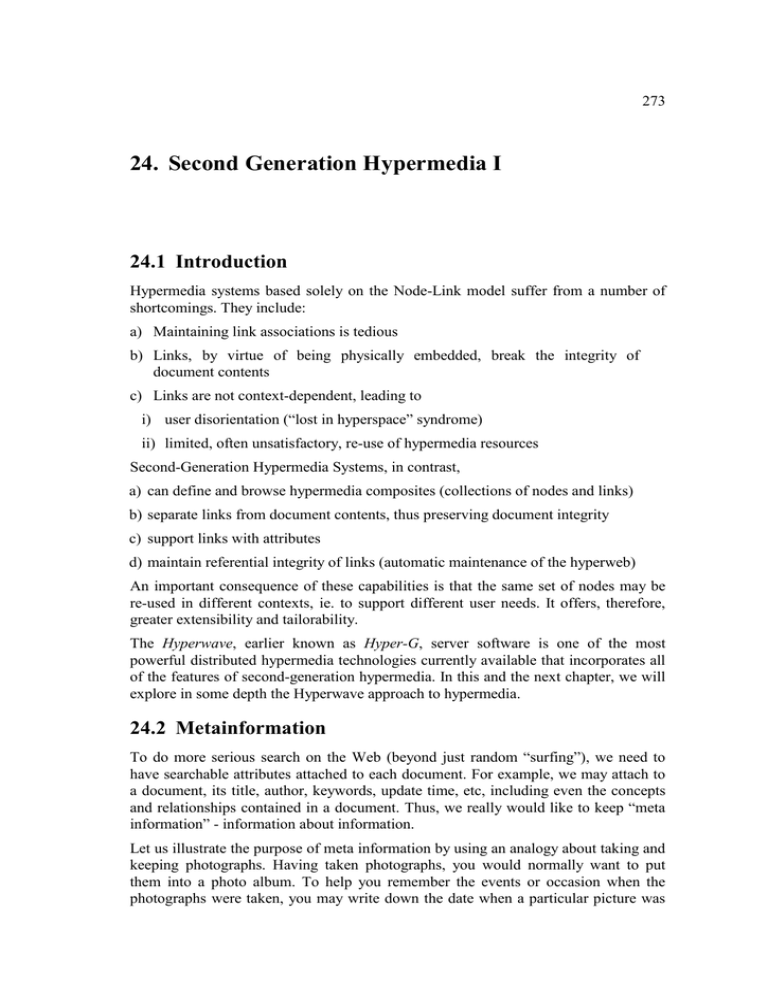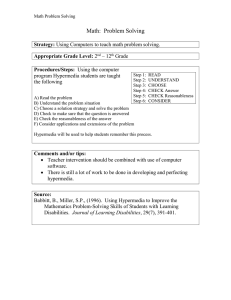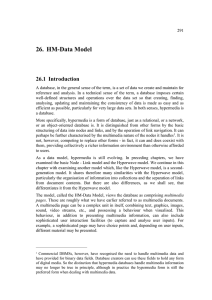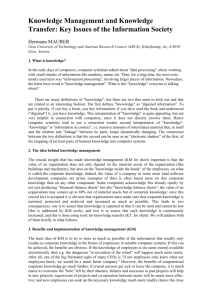hm_l6.doc
advertisement

273 24. Second Generation Hypermedia I 24.1 Introduction Hypermedia systems based solely on the Node-Link model suffer from a number of shortcomings. They include: a) Maintaining link associations is tedious b) Links, by virtue of being physically embedded, break the integrity of document contents c) Links are not context-dependent, leading to i) user disorientation (“lost in hyperspace” syndrome) ii) limited, often unsatisfactory, re-use of hypermedia resources Second-Generation Hypermedia Systems, in contrast, a) can define and browse hypermedia composites (collections of nodes and links) b) separate links from document contents, thus preserving document integrity c) support links with attributes d) maintain referential integrity of links (automatic maintenance of the hyperweb) An important consequence of these capabilities is that the same set of nodes may be re-used in different contexts, ie. to support different user needs. It offers, therefore, greater extensibility and tailorability. The Hyperwave, earlier known as Hyper-G, server software is one of the most powerful distributed hypermedia technologies currently available that incorporates all of the features of second-generation hypermedia. In this and the next chapter, we will explore in some depth the Hyperwave approach to hypermedia. 24.2 Metainformation To do more serious search on the Web (beyond just random “surfing”), we need to have searchable attributes attached to each document. For example, we may attach to a document, its title, author, keywords, update time, etc, including even the concepts and relationships contained in a document. Thus, we really would like to keep “meta information” - information about information. Let us illustrate the purpose of meta information by using an analogy about taking and keeping photographs. Having taken photographs, you would normally want to put them into a photo album. To help you remember the events or occasion when the photographs were taken, you may write down the date when a particular picture was 274 24. Second Generation Hypermedia I taken, who is in the picture, and where this picture was snapped. Information that describes the photographs is the meta information that can help you recollect the memories as you look again at the photographs perhaps two years later. Equally important too, the meta information could be used should you wish to organize your entire photograph collection by date or by place, for example. Later on, should you want to search the collection based on some attribute value (say, to find photographs taken at “Place X”), then the search can be conducted more efficiently. You can similarly do this with Hyperwave. In addition to the actual document itself, you can add meta information attributes that describe the kind of information the document contains. Thus you can use meta information for powerful searching. You can look for a document that contains the word “PC” that was authored by “Author X”, and that was inserted into the server after “Date Y”. You can also use these attributes for other applications in a way that automates some tasks. For example, you may deposit an announcement with an expiration date. When this expiration date is due, the computer system removes the expired document automatically. Likewise, managing a calendar of events is simplified. In a calendar of events, there is typically a list of dates, and for each date, there is a reference to some pertinent document showing what is happening on that date. The problem is when, the date say, March 9th changes to March 10th. To have to manually remember to update the list and remove the expired document is rather tedious. A system with stored meta information however can do such a task automatically. 24.3 Collections The Hyperwave data model extends the Node-Link model with an information structuring facility orthogonal to hyperlinking. More specifically, Hyperwave introduces the notion of a collection of objects. A Hyperwave collection is a composite object, comprising documents and/or other collections. It is analogous to folders or directories in a file system whose contents are files and/or other folders or directories. The Hyperwave collection therefore describes a hierarchy of collections. The basis of this recursive definition is of course a document or an empty collection, in much the same way that files or empty directories form the leaves of a hierarchical file sytem. Every Hyperwave server has one root collection - that which is the root of the hierarchy. Subsequently: a) every document or collection must be a member of at least one other collection, generically referred to as the parent collection (except, of course, the root collection which has no parent) 24. Second Generation Hypermedia I 275 b) while a document or collection can be a member of more than one collection, the collection hierarchy must be cycle-free Thus, a Hyperwave collection hierarchy is more accurately described as a directed acyclic graph (see Figure 24-1). Note the significance of allowing a document or collection to have more than one parent: different contexts can be defined to suit the needs of different users while still benefitting from sharing media objects. A Hyperwave collection is used for a number of purposes: 1. As a means of navigating through available information. Figure 24-1 Hyperwave Collection 2. As a means of establishing the context of the current focus. The collection can be visualised in ways that allow a user to select a member object (document or another collection) to be the “current focus”. Depending on the browser and the hardware platform it runs on, a collection may be visualised as a menu of member objects that users select using a keyboard (as in navigating the file system in a Unix shell or MS-DOS shell), or a graphics display directly manipulated through a mouse (as in the Windows Explorer GUI to the Windows file system), etc. Figure 24-2 illustrates a sample GUI visualisation. Users of the Windows Explorer GUI will immediately appreciate the similarity and the kind of interactivity it allows. Figure 24-2 Possible visualization a collection hierarchy 276 24. Second Generation Hypermedia I An object in focus will be visualised in ways that are object-dependent, eg. an HTML document will be formatted and displayed in a window or sub-window, a music object will play music, etc. Note that in Figure 24-2 the current focus is highlighted (in this case by a rectangle enclosing the object in focus). But as the surrounding portion of the hierarchy containing the focus is also displayed, its context may be easily determined at a glance. This helps to minimise the feeling of being lost as users navigate through various collections. This is especially significant in light of the fact that a given document or collection may be used in different contexts, as mentioned earlier. Collection Head Another common problem of navigating a hyperspace is that users often cannot determine the relevance or otherwise of a document until it is retrieved and its contents viewed. Even with an explicit display of the logical structure of information, the short titles of collections or documents are often not good indicators of their relevance to the user. To help alleviate this problem, a Hyperwave collection may also have a document designated as the collection head. If such a document exists, it would be automatically visualised when the collection is accessed (ie. navigated to), together with the hierarchy display. Authors may therefore use this facility to create a (multimedia) synopsis of the collection’s contents to help a user decide its relevance. Figure 24-2 shows a possible visualisation of a collection and its designated head. We assume the collection accessed is the one entitled “IICM Information Server”. Accessing it causes the display of the hierarchy to reveal its members (represented by titled icons). Additionally, because the collection has a head entitled “Welcome to IICM (Head)”, it automatically comes into focus and is simultaneously visualised in the bottom half of the display. Users can therefore get a better idea of the collection contents before navigating to any of its other members. Figure 24-2 Possible visualisation of a collection with a head document 24. Second Generation Hypermedia I 277 Additionally, the head may also provide links to other members of the collection. While this is redundant in a way, it provides users with alternative navigation mechanisms: use the hierarchy or use the links in the collection head. Note that if links are used for navigation, the hierarchy display will still be updated to reflect the context of the current focus. A collection head that visualises links to all other sibling members in the collection is called a full collection head. It is, however, the author’s responsibility to ensure that a full collection head really contains all necessary links (the nature of links in Hyperwave will be discussed later). Maintaining Collections In the node - link model, the idea of collections is loosely approximated by the concept of a ‘home page’. A home page contains links to other pages, from which more pages become accessible, and so on. Thus a university, say, may have a home page that contains links to other pages describing its faculties, which in turn have links to pages describing academic programmes, staff, facilities, and so on. The university home page itself may of course be part of a bigger collection, say, a home page on universities in a particular country. In other words, related collections of information are implemented through links1. This also means that when a new node is to be added to a collection, some existing node in the collection must also be edited to create a link to it - otherwise it will not be part of the collection. A Hyperwave collection, in contrast, is a structuring mechanism orthogonal to links. Related information may be grouped into a collection independently of links to/from them, ie. adding a new node to a collection does not require the creation of a link to it from some other node in the collection. The added node is immediately accessible through collection hierarchy navigation. Links to/from the new node may be added later and, as we shall see, in a way that supports multiple usage contexts while preserving its logical . Similarly, the deletion of a node in the node-link model requires updating nodes that link to it. In fact, this poses a major problem: how do we know which nodes point to the one we are deleting? Given that first-generation links are unidirectional, the only way to be sure is to check every node in the web! This is clearly impractical since nodes may be anywhere in the world and, even if we could determine the documents in question, they could reside on machines to which we have no write access. In practice, therefore, the first-generation web community accepts the fact that a link active today may become a dangling link tomorrow. In contrast, when deleting a node from a Hyperwave collection, the system automatically maintains the integrity of both the collection hierarchy and global links, with no additional effort needed on the part of the user. If the node also belongs to another collection, deletion does not affect its presence there. In other words, a node is 1 Collection boundaries are fuzzy, however, since any inter-collection relationship is also represented by the same link mechanism. 278 24. Second Generation Hypermedia I only physically deleted when it is removed from every collection that contains it. As for links, let us just assert for now that dangling links will not occur as a result of the deletion (how this is possible will be discussed in section 25.3). Thus, from the user’s point of view, maintaining a logical collection of information is far easier in Hyperwave. Insertion and deletion of nodes are one-step processes for the user - much of the work in maintaining the integrity of collections and links is automatically performed by the system. 24.4 Sequences While links let users freely navigate an information space, some collections of information are still better presented in linear order. For example, it is probably best for a new student to first work through a set of lessons in some predetermined order before navigating more freely among them. Of course, we can use links to organise things into a linear order. But recognising the frequent need for such linear structures, Hyperwave directly supports a special type of collection called a sequence. In object-oriented terms, a sequence is a subclass of the collection data class, ie. it is still basically a collection, but with the added property that a sort order is imposed on its members. It remains therefore a structuring mechanism different from and independent of links. The sort order of members is specified as an attribute of the sequence, which will typically specify sorting based on attributes of member elements, eg. date of creation, alphabetical order of element title, etc. Alternatively, each member of a sequence can have a sequence number attribute. A sequence imposes a constraint in the visualisation of members. Specifically, visualisation must begin with the first member of a sequence. Subsequently, navigation within the sequence is restricted to the ‘Next’, ‘Previous’, ‘First’ or ‘Last’ operations, respectively focusing and visualising the next, previous, first or last member in the sequence’s sort order. Of course, a user may exit a sequence using the ‘Exit’ operation at any time2. This is illustrated in Figure 24-3. Note that a sequence creates in effect virtual bidirectional links between its members. This is why, from any member, we can only navigate to the previous or next member in the sort order. Navigation to the first or last element may be viewed as repeating previous or next operations, respectively, until the first or last element is reached. Of course, this constraint may be manifested in the user interface in various ways. The figure shows one possible manifestation: a navigation bar with clickable icons for the allowed operations. Thus, with the state of browsing as shown here, selection of ‘Next’ will visualise the member “3”, ‘Previous’ the member “1”, ‘First’ the member “1” and ‘Last’ the member “5”. 2 Since a sequence is orthogonal to links, alternative navigation structures not subject to sequence navigation constraints may of course be defined over the same elements. Direct access to individual elements may also be effected by setting up a parallel collection (with a full collection head) that shares the sequence elements. 24. Second Generation Hypermedia I 279 Figure 24-3 Sequence Visualisation Note that the virtual links between sequence members are dynamically generated. Thus, if document “2” above was deleted, the virtual structure of the sequence automatically becomes: “1””3” ”4” ”5” Similarly, addition of a new member will insert it in the appropriate position as dictated by the user-specified sort order for the collection. The system guarantees that the sequence will always be in a consistent state. The provision of this special class of collections greatly simplifies the creation and maintenance of linear information structures. Also significant is that the integrity of such structures is dynamically maintained, ie. changes due to insertions and deletions can happen even during browsing. Being able to specify implicit sort orders is also a very powerful feature. In all, it regularises the form and handling of linear information, facilitating a more consistent browsing interface (eg. a standard navigation bar) and a more uniform behaviour. The node - link model, in contrast, will require that authors manually establish and maintain the consistency of links whenever documents are inserted or deleted. Changes, therefore, cannot be done on-the-fly. Moreover, different authors may implement linear structures differently, eg. some may use uni-directional links, others may use bi-directional links, and yet others may link elements into a circular list, etc. The lack of a standard definition of a linear structure leads also to different presentation metaphors that are likely to confuse end-users. We have casually talked about collections and elements above as possessing attributes. This is in fact another distinguishing feature of nodes and links in secondgeneration systems, ie. they are best treated as objects that, in addition to the information they carry, have attributes describing them. Some are system-defined attributes such as creation date, document type, etc., but users can also define custom attributes. The details are treated elsewhere in the book - it suffices to note here that such attributes, or metadata, are themselves searchable in Hyperwave (and in secondgeneration systems, in general). As we saw above, the sort order may be specified on the objects’ metadata. 280 24. Second Generation Hypermedia I 24.5 Conclusion Grouping related material in advance into collection hierarchies has many obvious advantages. One advantage is that you can restrict the search scope to a collection and its subcollections, and thus making it easier to search for something. It is also easier to produce a CD-ROM because you can just press a part of the database on the CDROM. Furthermore, the use of collections eases navigation because having the document hierarchy is like having a hierarchical overview of geographical maps of different scales - world, continent, country, city, district, etc - along with a local map. Data administration is eased too as the collections behave like directories in file systems. Figure 24-5 Restricting the search scope The most important advantage of the collection hierarchy is that much link editing disappears as the system takes over many of the chores. Consider the following example. A company keeps a list of its employees and this is kept in alphabetical order. Normally this is implemented as a list of the key field (say the name), where each entry in this list points to a document containing the detailed information of the employee. See Figure 24-6(a). Figure 24-6 Link Maintanance 24. Second Generation Hypermedia I 281 A new employee joins the company. Firstly, his employee document is created. Depending on the value of his key field (his name), an entry is created to be inserted into the list of key fields. Existing links would have to be “adjusted” to accommodate this new entry whilst maintaining the alphabetical ordering. For example, in the illustration (Figure 24-6 (b)) above, we would like to insert “Milner”. The link between “Codd” and “Olle” is severed. Three new links between “List-Milner”, “Codd-Milner” and “Milner-Olle” are created. This seems a tedious link maintenance job for the author or data administrator who has to manually establish and maintain the consistency of links whenever documents are added or deleted. Compare this situation if the document is to be inserted into a Hyperwave collection. Here, if one were to insert the new document into a “sequence” (as discussed in section 24.4 above) where the sort order of members is specified as an attribute of the collection, then the newly created document is automatically accessible in the right order without any manual link creation or editing. Thus the maintenance job of the information provider is greatly reduced. Another important advantage of composites in general and of Hyperwave collections, in particular, is the ability to customize the hyperweb. Again, let us illustrate this with an example as follows: We have 6 educational modules, A to F, and we have three users with different learning profiles. We want to supply them with different modules according to their preferences. For example, User 1 would like Modules A, B, E and F whilst User 2 would like Modules D, B and C; and so on. Figure 24-7 Customization The only way to do this in ordinary WWW is to actually copy these modules a number of times and link them manually according to the individual needs of the users. See Figure 24-7 (a) above. An obvious solution in Hyperwave is the use of separate collections. We can, for example, use a blue, red and green collection. We then copy these modules into those collections. However, we do not copy in the sense of duplicating the same modules 282 24. Second Generation Hypermedia I many times. Instead, we just add a reference to the module. This is called “virtual copying”. These three collections do not really contain the modules but instead have pointers to the modules (as shown in Figure 24-7 (b) above). Thus in Hyperwave, the main documents or structural elements can be seen as selfcontained, reusable hypermedia components, similar to procedures in programming languages.




